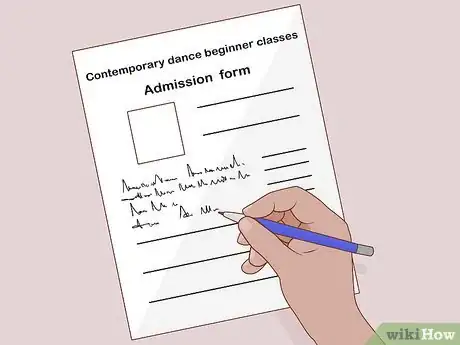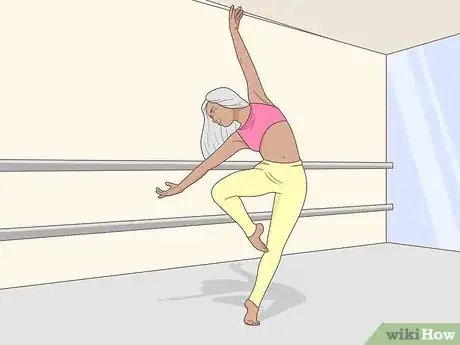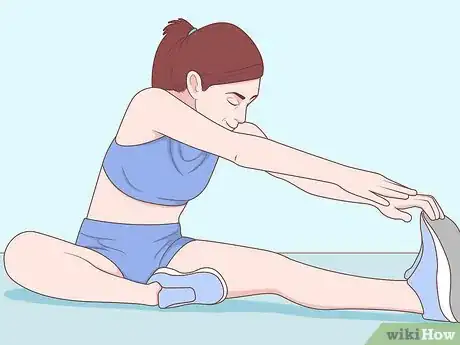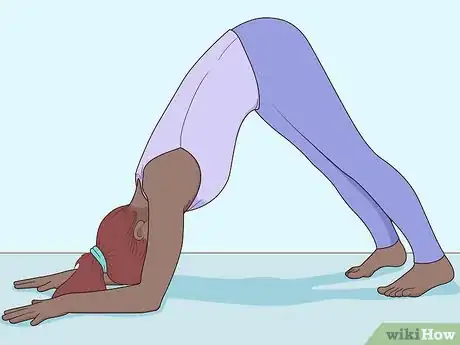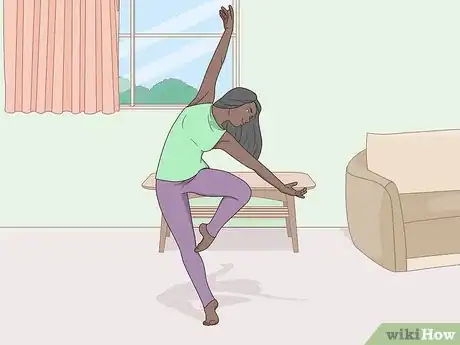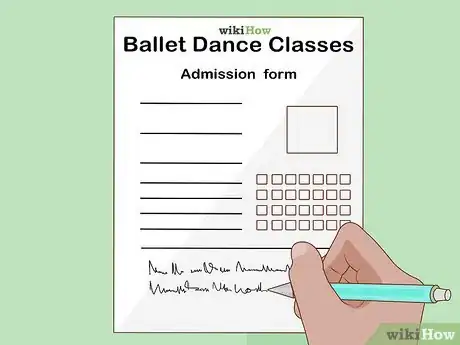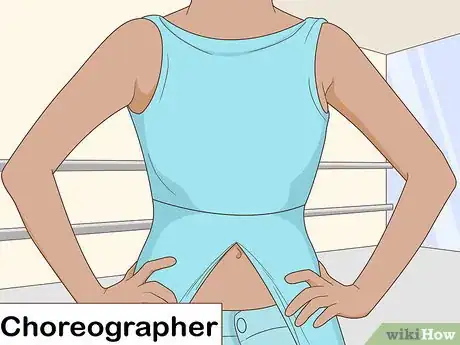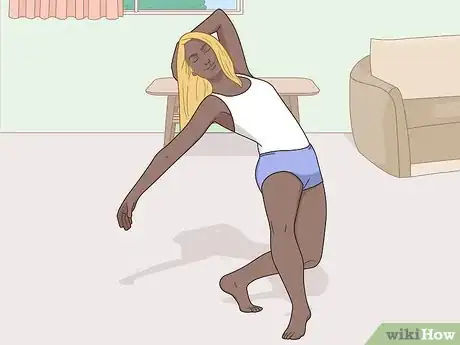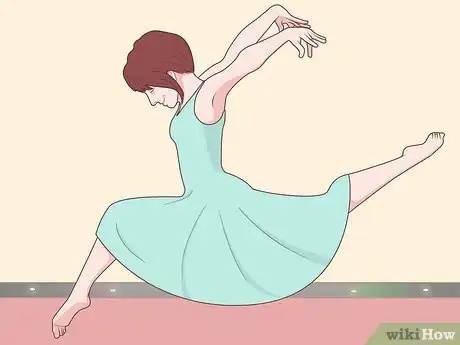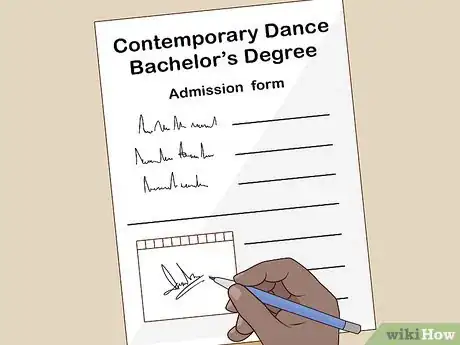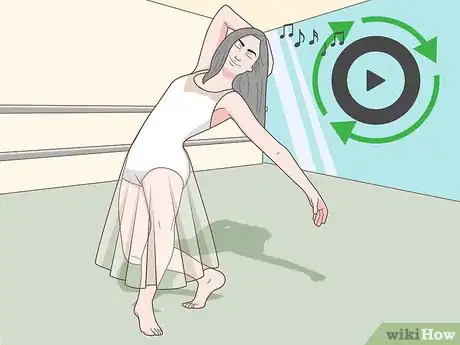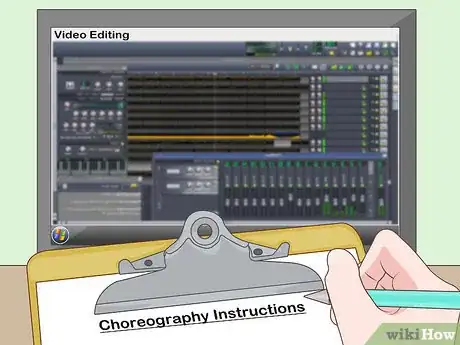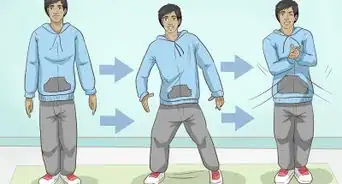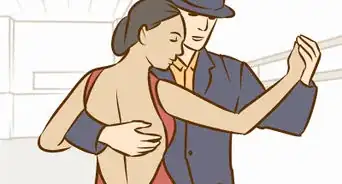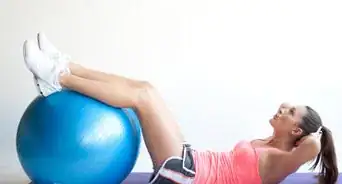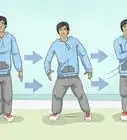This article was co-authored by Val Cunningham and by wikiHow staff writer, Amber Crain. Val Cunningham is a Choreographer, Lead Dance Instructor, and Certified Yoga Instructor at The Dance Loft, a dance studio based in San Francisco, California. Val has over 23 years of dance instruction, performance, and choreography experience and specializes in ballroom, Latin, and swing dancing. She is also trained in house, hip-hop, jazz, ballet, and modern dance, and has studied with world renouned dancers such as Tom Slaterand Richard Lambarty. She is ISTD (Imperial Society of Teachers of Dancing), ProDVIDA (Professional Dance Vision International Dance Association), and Zumba certified. She is a member of the National Dance Council of America.
This article has been viewed 139,875 times.
Contemporary dance was established in the early 1900s and is now one of the most popular dance styles in the Western world. It emphasizes freedom of expression through movement rather than rigid techniques. Start by enrolling in a class for beginners. From there, work on building your strength, flexibility, and learning advanced techniques. To dance professionally, enroll in an advanced dance program at a university or dance school, then train to enter the professional world.
Steps
Taking Beginner Classes
-
1Sign up for a contemporary dance class. Make sure the class is for beginners and, if possible, targeted for your age group. Look for a dancing school that is close to home and fits your budget. If there are no contemporary dance classes in your area, look into taking private lessons.[1]
- You can always ask for a trial lesson or set of lessons; it's important to feel comfortable with the class and click with the teacher.
-
2Work on coordination and rhythm. Put on whatever style of music you like best and practice staying on-beat, making fluid movements and increasing your range of motion.[2] Contemporary dance doesn’t emphasize rigid techniques, straight lines, or pointed movements. Instead, it’s about fluid movement, freedom of expression, and improvisation. Keep this in mind as you practice.
- You’ll work on this in your class, but home practice only makes you better.
Advertisement -
3Stretch daily to increase your flexibility.[3] Contemporary dancers need to be flexible to do leaps, jumps, and many other common moves. Stretch every morning and evening. Start out slowly with stretching and gradually push a little harder to get more flexible – it doesn’t happen overnight! With regular stretching and exercise, you will become more flexible over time.
- Start with static stretching, which means doing any given stretch to the point of tension, and then holding that pose for 10 to 60 seconds. Try doing toe touches and split stretches to increase flexibility.
-
4Do yoga to increase your abilities. Yoga increases flexibility, but it also shares many other important traits with contemporary dance.[4] It’s recognized as one of the basic contemporary dance techniques because it emphasizes breathing, body alignment, mental control, and muscle relaxation – many of the same core techniques taught in contemporary dance.[5]
- You can take a yoga class or even follow yoga instruction videos online.
-
5Practice at home after your dance class. There will be moves that you can do easily, and others that don’t come as naturally. Work on those tough moves at home, after your class. You’ll feel more comfortable about messing up, since no one is watching you, and by the time the next class rolls around, you’ll already have those moves perfected.
- If possible, practice in front of a mirror. You can also take video of yourself and play it back later, then tweak your moves as needed.
- Use online videos if you need further instruction about a move you’re practicing at home.
Expanding Your Technique
-
1Study ballet to help you get better at contemporary dance techniques. Ballet emphasizes poise, balance, and control. Working diligently on these will make it easier for you to master advanced contemporary dance techniques. Most aspiring contemporary dancers take ballet classes as they advance in skill level.[6]
-
2Focus on strengthening your core muscles.[7] Many traditional dance styles focus on leg movements in their techniques. Contemporary dance focuses more on movements made from the torso area. Many of the advanced movements require a lot of torso strength and agility. Work on strength training at a gym, and consider learning some Pilates moves that focus on strengthening the torso.[8]
- Planks, side planks and side crunches are excellent core strengthening exercises for dancers.
-
3Work with a choreographer. Choreographers are basically the directors of a dance piece, and they usually created the dance piece themselves. They will instruct you very specifically and have control over the creative vision of the piece. To advance in contemporary dance, learn how to work with a choreographer. Conform your movements to their aesthetic vision and be open to new movements and styles.[9]
-
4Begin choreographing dance pieces yourself. Choreography is one of the most important aspects of contemporary dance because of the emphasis on expression. Learning how to choreograph dance pieces is basically learning how to express emotions and narratives with your body and its movements. Start by practicing choreography at home to your favorite songs. As you advance, look into classes that focus on choreography specifically.[10]
- Brainstorm themes, music, and possible narratives. Incorporate moves that you feel emulate the ideas you want to get across.
- Work on creating steps that play to your strengths as a dancer.[11]
-
5Take part in class performances. Public performances get you ready for a professional dancing career. Find out if your classes will have performances or recitals near the end of the term – most do. Try to get involved with these performances as much as possible. Learn everything you can and perform as frequently as you can.
Dancing Professionally
-
1Study contemporary dance at a university or dance school. Advancing in the world of dance usually requires experience gained through higher levels of education. Many schools offer bachelor’s degrees in dance, with a focus on contemporary dance. Be ready for an audition and in-person interview before you’re accepted, as many of these programs are extremely choosy.[12]
-
2Focus on and experiment with your choreography skills. Choreography becomes more and more important as you advance in contemporary dance. These programs usually emphasize creativity and experimentation, so explore your abilities. Work on creating your own dance style and creating strong narratives to go along with the chosen music.[13]
- Dance to lots of different kinds of music to expand your knowledge and abilities even more.
-
3Explore and hone your strengths as a performer. Aside from choreography, performance is the other main focus for dancers in advanced programs. Work on exploring performance scenarios, following choreography instruction and somatic practices. Many schools will provide you with video and sound editing software so you can learn how to present performances via installations, film and projection techniques.[14]
- Work on mock auditions to prepare yourself for your future as a professional dancer.
-
4Explore and audition for professional roles. Once you complete your degree, you’ll be a highly trained dancer. You can audition for dance companies, roles in ballets and contemporary dance performances with elite groups. You'll start working closely with other professionals in the field.
- Joining a professional dance company will give you the chance to express your artistic vision, travel, and even become involved in things like social activism.[15]
- If you don’t want to follow this path, you can become an advanced instructor yourself, which will give you the opportunity choreograph and teach other dancers your pieces.
Expert Q&A
Did you know you can get expert answers for this article?
Unlock expert answers by supporting wikiHow
-
QuestionHow can I train to improve my dancing?
 Val CunninghamVal Cunningham is a Choreographer, Lead Dance Instructor, and Certified Yoga Instructor at The Dance Loft, a dance studio based in San Francisco, California. Val has over 23 years of dance instruction, performance, and choreography experience and specializes in ballroom, Latin, and swing dancing. She is also trained in house, hip-hop, jazz, ballet, and modern dance, and has studied with world renouned dancers such as Tom Slaterand Richard Lambarty. She is ISTD (Imperial Society of Teachers of Dancing), ProDVIDA (Professional Dance Vision International Dance Association), and Zumba certified. She is a member of the National Dance Council of America.
Val CunninghamVal Cunningham is a Choreographer, Lead Dance Instructor, and Certified Yoga Instructor at The Dance Loft, a dance studio based in San Francisco, California. Val has over 23 years of dance instruction, performance, and choreography experience and specializes in ballroom, Latin, and swing dancing. She is also trained in house, hip-hop, jazz, ballet, and modern dance, and has studied with world renouned dancers such as Tom Slaterand Richard Lambarty. She is ISTD (Imperial Society of Teachers of Dancing), ProDVIDA (Professional Dance Vision International Dance Association), and Zumba certified. She is a member of the National Dance Council of America.
Certified Dance & Yoga Instructor Yoga practice really helps with flexibility, breath, and being able to ground yourself and remain poised. Keeping a fitness routine, meaning cardio and pushing the heart rate for extensive periods of time, is also important in order to give yourself longevity within your body. Consider weight lifting or pilates in addition to help your muscles stay firm.
Yoga practice really helps with flexibility, breath, and being able to ground yourself and remain poised. Keeping a fitness routine, meaning cardio and pushing the heart rate for extensive periods of time, is also important in order to give yourself longevity within your body. Consider weight lifting or pilates in addition to help your muscles stay firm. -
QuestionHow can I become a more confident dancer?
 Val CunninghamVal Cunningham is a Choreographer, Lead Dance Instructor, and Certified Yoga Instructor at The Dance Loft, a dance studio based in San Francisco, California. Val has over 23 years of dance instruction, performance, and choreography experience and specializes in ballroom, Latin, and swing dancing. She is also trained in house, hip-hop, jazz, ballet, and modern dance, and has studied with world renouned dancers such as Tom Slaterand Richard Lambarty. She is ISTD (Imperial Society of Teachers of Dancing), ProDVIDA (Professional Dance Vision International Dance Association), and Zumba certified. She is a member of the National Dance Council of America.
Val CunninghamVal Cunningham is a Choreographer, Lead Dance Instructor, and Certified Yoga Instructor at The Dance Loft, a dance studio based in San Francisco, California. Val has over 23 years of dance instruction, performance, and choreography experience and specializes in ballroom, Latin, and swing dancing. She is also trained in house, hip-hop, jazz, ballet, and modern dance, and has studied with world renouned dancers such as Tom Slaterand Richard Lambarty. She is ISTD (Imperial Society of Teachers of Dancing), ProDVIDA (Professional Dance Vision International Dance Association), and Zumba certified. She is a member of the National Dance Council of America.
Certified Dance & Yoga Instructor Gaining confidence is a journey. The more you practice, the better you become, and then you organically gain confidence as a result. Having a sense of humor regarding mistakes or things that don't look right is another key to success. Think of your dancing as a journey and commend yourself for the absolute action of trying.
Gaining confidence is a journey. The more you practice, the better you become, and then you organically gain confidence as a result. Having a sense of humor regarding mistakes or things that don't look right is another key to success. Think of your dancing as a journey and commend yourself for the absolute action of trying. -
QuestionWhat if I am really not flexible?
 Community AnswerTry stretching a little bit each day. You will see a difference after awhile. Even if you are not flexible, little stretches will do the trick.
Community AnswerTry stretching a little bit each day. You will see a difference after awhile. Even if you are not flexible, little stretches will do the trick.
References
- ↑ http://takelessons.com/blog/contemporary-dance-for-beginners
- ↑ Val Cunningham. Certified Dance & Yoga Instructor. Expert Interview. 6 February 2020.
- ↑ Val Cunningham. Certified Dance & Yoga Instructor. Expert Interview. 6 February 2020.
- ↑ Val Cunningham. Certified Dance & Yoga Instructor. Expert Interview. 6 February 2020.
- ↑ http://www.contemporary-dance.org/contemporary-dance-techniques.html
- ↑ http://takelessons.com/blog/contemporary-dance-for-beginners
- ↑ Val Cunningham. Certified Dance & Yoga Instructor. Expert Interview. 6 February 2020.
- ↑ http://takelessons.com/blog/contemporary-dance-for-beginners
- ↑ http://takelessons.com/blog/contemporary-dance-for-beginners
